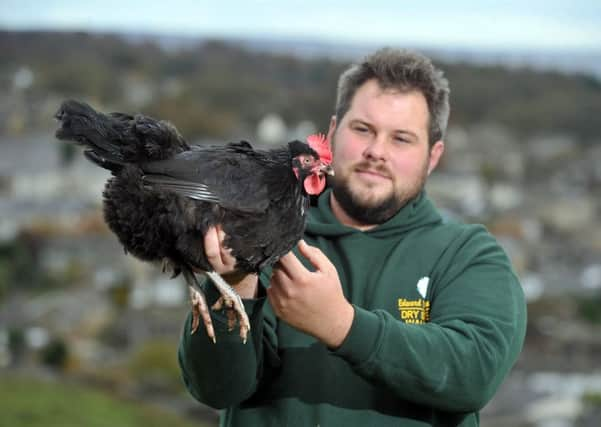West Yorkshire breeder's dark plot for the perfect eggs


Edward Dickinson’s plan was to breed a clean-legged, fast-maturing black hen that would produce the brown eggs that buyers demand. Ten years later and he has produced the Oakworth.
Edward’s hen and egg journey began 20 years ago when he was 10-years-old. His father Graham was an architect living in Silsden and a weekly meeting with Graham’s property developer colleague Ernest Marshall saw Edward collecting the eggs from Ernest’s poultry ready for the Saturday morning fry-up.
Advertisement
Hide AdAdvertisement
Hide Ad“I think Ernest saw a keenness in me for the hens and he gave me two, plus a big bag of corn. He told me to keep a record of the corn I used, the eggs I sold and how I would then see a profit. I bought a little book and recorded for a while but I really enjoyed the hens regardless and started becoming interested in the different breeds. I was hooked right away. Dad and I went to Jack Killeen at Burley Woodhead near Ilkley just two weeks after starting with the two hens. Jack specialised in pure and native breeds and we bought six Croad Langshans, a Chinese breed.”
The die was cast and Edward was happy with his hens.
“My brother had motorbikes so I think dad thought hens were a cheaper option. We then moved to Oxenhope. I changed from the Langshans to French Marans and Welsummers. I got up to around 100 hens and at about 16-years-old I couldn’t go on holiday because I had the hens to look after.”
Joining Silsden YFC and stockjudging cattle and sheep brought about a greater interest in agriculture and he took a course in countryside and forestry at Craven College before work experience in drystone walling with local man Tom Atkins. Edward became a professional drystone waller and the craft still provides his main income and has this year seen him work on estates in Scotland, further south in Oxford and in Yorkshire. Four years ago he went alone having previously been involved with a larger company.
The hens have remained though and today he rents land just out of Oakworth. A decade ago he began his labour of love - coming up with the new breed.
Advertisement
Hide AdAdvertisement
Hide Ad“I’d had this idea of how I could mix Mediterranean fowl, which are extremely hardy, fast-maturing and productive but I wanted to produce dark brown eggs and theirs were white. Speed of maturity and hardiness were major points for me, but the colour of the egg was another essential requirement. My first cross was the Dutch Welsummer cockerel with the French Maran hen.
“The French Maran lay really dark brown eggs but they have feathered legs and that means in the nest their feathery feet and legs drag muck all over the eggs, so with the Welsummer I was trying to get rid of the feathery legs. From that cross I started selecting only those that came out with clean legs.
“My next step was to take the cockerels from that mating and put them to the White Leghorn. That brought about a hen that laid a huge egg and was a prolific layer but it was a pale coloured egg.
“I’d also found that I would then be producing light coloured hens with yellow legs. I wanted black or white legs, so I had to get rid of those with yellow legs and keep those with black or white. I then put the father of the Welsummer X French Maran back on to those that I had the White Leghorn in but with the right colour legs.
Advertisement
Hide AdAdvertisement
Hide Ad“I’d tried others. At one time the Minorca from Spain was a contender but it didn’t have the egg-producing quantity that I was getting by having introduced the Leghorn.
“In the end it was the grandfather of the Welsummer X French Maran, with the influence of the prolific egg-laying quantity of the White Leghorn and then the British Cuckoo Maran to get the black colour I was looking for along with the dark brown egg that has now brought about what is the Oakworth.
“It has taken ten years but I now have a black hen that is fast-maturing, clean-legged, gives great quantity and quality of dark brown eggs and starts laying at 21 weeks.”
OAKWORTH AN 80-YEAR FIRST?
Edward builds drystone walls in the Pennine style using a steep batter and he recently worked at Sutherland on Scotland’s north coast and near Inverness.
Advertisement
Hide AdAdvertisement
Hide AdEdward’s poultry business is called Dickinson’s Dark Egg Layers. Other breeds he tried using in search of the Oakworth were Redcaps, Hamburgs and Barnevelders. He now has 40 Oakworths and is selling the eggs and hens commercially.
“People want dark brown eggs. When they’re buying they don’t want light eggs. I’m now breeding the Oakworth completely pure. From my studies it seems I’ve come up with the first all-new breed in 80 years.”